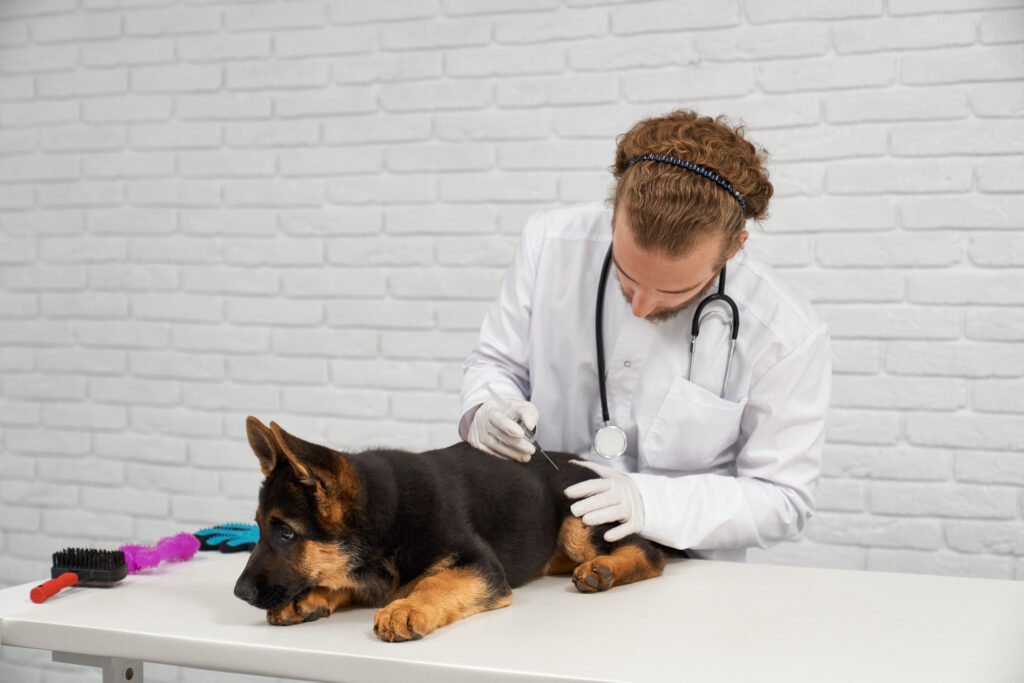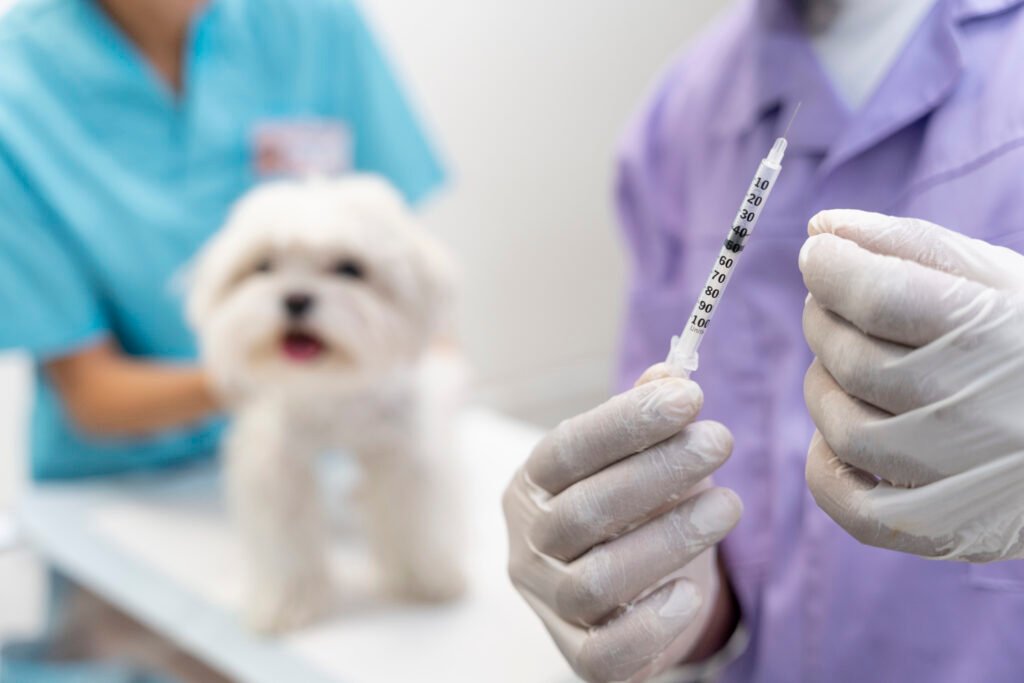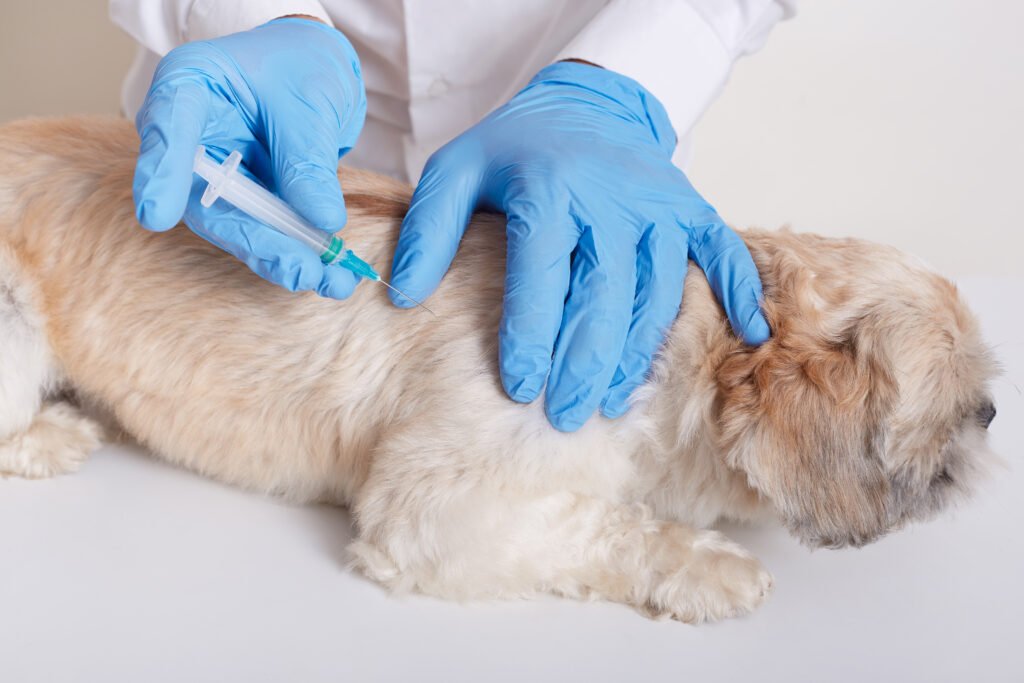Core Vaccinations for Dogs and Cats
Core dog vaccines are the most important vaccinations that prevent pets from fatal illnesses. These are typically the rabies, distemper, and parvovirus vaccines, plus the canine adenovirus. This is a core set of vaccines for rabies, feline viral rhinotracheitis (upper respiratory infection), calicivirus (respiratory illness similar to “kennel cough” in dogs), and panleukopenia.
Importance: It is important to give these vaccines because they prevent highly contagious diseases that can be fatal or even cause human disease (rabies) as well. Administering these vaccines as prescribed will make your pet immune to most of them throughout its life and also protect public health by inhibiting the spread of harmful illnesses.

Importance of Core Dog Vaccines for All Dogs and Cats
Core vaccinations are a key component to helping dogs and cats live long, healthy lives. The vaccines for these diseases are not only prevalent but also deadly. Let’s take a closer look at why they are so critical:
1.Immunity Against Infectious Disease Especially contagious ones.
Common Occurrence: Core vaccines protect against widespread and regionally common diseases that can lead to serious illness or be shared between pets, and in some cases, from pets to humans. Unvaccinated dogs in a shelter or place where this has been present would be at extremely high risk, as there is little treatment for this and the vaccine may not replicate exactly but only time will tell (an example of an animal disease known to affect both wild animals held captive was canine parvovirus which survives well outside hosts).
High Mortality: For example, diseases such as distemper in dogs or panleukopenia infections is most associated with the high mortality rate which was especially for young animals influencers not being vaccinated. Core vaccines can prevent these frequently fatal diseases — and in many cases, save a pet’s life.
2.Public Health Considerations:
Zoonotic Risks: Rabies, along with other core diseases, are zoonosis due to infection being transmittable by animals to humans as well. Symptoms will present in humans and once rabies symptoms appear, the disease is almost always fatal so vaccination is equally important for human health as well. Rabies vaccination laws are common in many countries to prevent rabies outbreaks.
Legal Regulations: Rabies and certain other core vaccinations are legally required in a number of areas If a rabies exposure incident occurs and your pet is not vaccinated, you can face legal sanctions that could include fines as well as enforced quarantine of the animal.
3.Containment of Outbreaks and Epidemics:
Herd Immunity: When a high percentage of pets are vaccinated against diseases, it prevents the spread of these diseases even among unvaccinated or immunosuppressed animals. Is an indispensable collective immunity that helps control and cancel infectious diseases within a population.
Disease can quickly become an epidemic if it is not kept under control, and without a large proportion of animals vaccinated at once this will happen much quicker than before – meaning general sickness among pets could increase massively as well. Vaccines are administered to help limit disease and core vaccinations ensure that the chances of getting sick with a preventable disease has been lessened.
4.Early Life Protection:
Vaccination is critical: Puppies and kittens are especially susceptible to infectious diseases for they have not yet developed immunity. These core vaccines are what they need during the first few months of life to give them that immunity gratefully received %% An example of this is the canine distemper vaccine: it is frequently administered in multiple injections from 6-8 weeks onward to provide early protection.
Vaccination times teaches future health: Vaccinating while young not only protects the animal today but for years to come. Many of the core vaccines protect against pathogens that can confer long-lasting immunity, which is why animals generally won’t need as many boosters every year when they get older. This long lasting protection helps to prevent these diseases for the life of your pet.
5.Vaccine Efficacy and Safety:
Core Vaccines have been around and well-studied for many years with no pressing problems related to their use. Tier 2 vaccines are frequently boosters to Tier 1 and have been heavily tested for antigenicity with minimal risks associated.
Risk-Benefit Ratio: Even though no medical procedure is without risk, the benefits of core vaccinations are worth any potential risks. Common side effects the dog may experience in response to DHPP include some mild and short-term ones, Like a little swelling at the injection site or lethargy. While serious side effects are extremely rare, the benefits of these vaccines in terms of protection is such that they far outweigh any risks.
6.Global Health Impact:
Consistency Across Regions: Important, or core vaccinations are internationally promoted as important for overall pet health. This standard helps to keep the level of care as high as possible. Ensuring every pet, no matter where they are in the world, is safeguarded against dangerous diseases such as parvovirus or rabies.
Variability to local diseases by geography: The specific core vaccines may differ slightly based on disease prevalence related to the area, but still grounded in the same principle; Comprehensive protection against environmental dangers.
In other words, dogs and cats should receive core vaccinations because they help in the overall process of keeping pets healthy by avoiding highly contagious diseases and life-threatening infections for the animal population at large, controlling disease outbreaks in case an infection takes place,, allows early benefits to pet health while providing long lasting protection. These vaccines being implemented universally have led to a steep decrease in the number of certain dangerous diseases, which overall has conditioned animals and their people for a healthier life.

Core vaccines protect against life-shortening diseases
Core vaccines work by triggering the immune response to recognize and resist particular pathogens in order to prevent life-threatening diseases. On a more granular level, this is how they operate:
Immune System Activation:
- Practicing Infection: Antigens in common vaccines simulate the pathogens (AKA viruses or bacteria) without causing infectious diseases. When your pet is vaccinated, these antigens are injected into the body to mimic an actual exposure and cause their immune system to respond in kind.
- Memory Cells: The immune system also generates memory cells that remember the pathogenic agent. Therefore, if the pet is exposed to the real disease at some point down the road, those memory cells will immediately recognize it and lead a swift and powerful immune response because of which infection does not become established.
Preventing Disease Onset:
- Catches Early On: Core vaccines work best for pets, helping to protect them from very serious and fast-spreading diseases. The immune system is subsequently triggered by the vaccine to destroy and contain the pathogen before it can commodity a swarm, halting dysentery in its tracks.
- Vaccinated pets may develop the disease if fully vaccinated (which is not very common) but will tend to have a milder and shorter-lasting illness than an unvaccinated pet. This implies that vaccinated animals are likely to be more successful at surviving infection with less severe signs.
Long-Term Protection:
- Durations Of Immunity Vary: Most core vaccines provide years or even a lifetime of immunity. The long term nature of this protection is important in a lethal infectious disease like rabies. Booster shots serve to keep this immunity alive over time.
- Community Immunity: Also known as herd immunity, core vaccines help create this phenomenon by vaccinating a high percentage of pets. This will result in a decreased prevalence of the disease overall, and less infectious agents present in the environment means that there is a smaller chance any one individual animal (be it vaccinated or not) would be exposed.
Immunity to Multiple Pathogens:
Alternatively, Some core vaccines are combination vaccines which provide concurrent protection against multiple pathogens with a single dose. The DHPP vaccine for dogs, for instance, covers distemper, hepatitis, parvovirus and parainfluenza. This comprehensive protection decreases the need for many booster vaccines, while still ensuring that a pet will be well protected against prevalent and life-threatening diseases.
Public Health Risks Mitigation
Core Vaccines Prevent Rabies: One of the most common examples I can think of that demonstrates how core vaccines protect pets AND humans is response to protecting against rabies. As if the name of this myth did not give it away, Suski explains a popular misconception surrounding rabies: Rabies is almost always fatal and is transferred from an animal to humans. Vaccination of pets keeps this fatal virus at bay, thus preventing the transmission from an infected animal to you or a person living in close proximity.
Supporting Overall Health:
Minimizing the Disease Burden: By protecting against diseases that could cause severe illness and even death, core vaccines help pets maintain long-term health. Pets that have been safeguarding against these diseases will be very difficult for them to fall sick at some point when the immune system has become weakened and hence other health related issues like on top of another.
In essence, core vaccines prime the immune systems to better identify and counter specific pathogens using live modified antigens when pets are exposed. They provide early and long-term immunity, shorten the severity of diseases, help others form communal resistance against health risks as well as to safeguard their surroundings. Together these bring about a riveting perspective that will allow your pets to lead healthier life spans in general diffusion from avoidable ailments coming before mankind into any occurrence so far referred to define pet living.

Core vaccines for dogs and cats are essential and follow specific schedules.
Core dog and cat vaccines are those that should be given to most dogs or cats, such as PARVOVIRUS for puppies. Every species has certain core vaccines that are recommended, and they should generally receive these starting early in life so that vaccination occurs well before exposure to disease. So let’s take a detailed look at the core vaccines for dogs and cats, along with when they should be administered.
Core Vaccines for Dogs:
Rabies:
Rabies is a deadly viral disease that attacks the central nervous system, and which people can get if they are bitten by an animal infected with rabies.
Vaccination Schedule:
First dose: 12-16 weeks of age
Booster- administered 1 year after the primary vaccination, then every 1 to 3 years depending on regional laws and the specific vaccine.
Distemper:
Disease: Canine distemper is a serious viral disease that affects the respiratory, gastrointestinal and nervous systems.
Vaccination Schedule:
Upland Game birds, the first dose usually starts around 6-8 weeks of age.
Boosters- Every 3 to 4 weeks until the puppy is about 16 to19+(40)weeks old.
Booster #2: 1 year later, every 1 – 3 years.
Canine Parvovirus:
Infection: Parvovirus is a highly contagious and often deadly viral infection that mainly attacks the intestines.
Vaccination Schedule:
1st Vaccine: Administered At 6 – 8 Weeks.
Vaccines: Every 3-4 weeks until puppy reaches ages of 16 -20 months.
3 dose primary series, 1 booster at one year followed by boosters every 1-3 years.
Canine Adenovirus (CAV-1 and CAV-2)
Disease: CAV-1 causes infectious canine hepatitis and CAV-2 is connected with respiratory disease (and contributes to kennel-cough.)
Vaccination Schedule:
Dose 1 : Just after birth Dose 2: between under age of six to eight weeks
Booster: At 3 to 4 week intervals until the puppy is between16 and 20 weeks age.
Booster additional: After 1 year, then every 1-3 years.
Core Vaccines for Cats:
Rabies:
Disease: Cat rabies is a deadly viral disease that leads to injury to the nervous system like dogs and can potentially be transmitted to people.
Vaccination Schedule:
First vaccination: Usually given at 12–16 weeks of age
Booster: 1st booster at 12 months after initial vaccination and once every year to three years depending on vaccine schedule & local regulation.
Feline Viral Rhinotracheitis (also known as Feline Herpesvirus type 1)
Disease: The most common cause of conjunctivitis in cats is an upper respiratory infection caused by feline viral rhinotracheitis.
Vaccination Schedule:
- Initial One: Probably started at 6 to 8 weeks of age.
- Booster Vaccinations: Every 3-4 weeks, until kitten is b/w 16 and 20 weeks.
- Booster 2: Administered following the initial series and then every year to 3 years.
Feline Calicivirus (FCV):
Calicivirus is another source of upper respiratory infections in felines as well and can cause oral ulcerations, thus it comes under disease.
Vaccination Schedule:
- First dose: 6-8 weeks old
- Booster — every 3–4 weeks until the cat is (16-20) weeks old.
- Another booster: 1 year after the last (then every 1-3 years)
Feline Panleukopenia (FPV) – Feline Distemper
Virus type: Panleukopenia — an extremely contagious, usually deadly, disease that assaults the gastrointestinal mucosa bone marrow in addition to the immune system.
Vaccination Schedule:
- Dosage: First Dose age 6 to 8 weeks,
- Thereafter, at 3-4 weekly intervals until the kitten is between 16 –20 weeks old.
- Another booster: 1 year after, then every 1 to three years.
Combination Vaccines:
Most of these core vaccines are used as multivalent vaccines to decrease the number of injections a pet receives. For example:
Felonies: The DHPP vaccine is a combination of Distemper, Hepatitis (Adenovirus), Parvovirus and Parainfluenza into one shot.
Cats: The FVRCP vaccine is an all-in-one injection that provides protection against three diseases, namely —Feline Viral Rhinotracheitis, Calicivirus and Panleukopenia.
Why is This Particular Schedule So Important?
It is important that this schedule be adhered to because it ensures the protection of puppies and kittens during their most susceptible periods. Vaccines at the proper time and age can provide immunity against these killer diseases before weaning or exposure. After the first series of vaccinations, life long immunity must be maintained with regular booster injections.
In a nutshell, core vaccines for dogs and cats are given to prevent an easy spread of these fatal diseases at the right age. This vaccination schedule will help pet owners make sure that their pets are healthy and protected from these potentially fatal diseases
